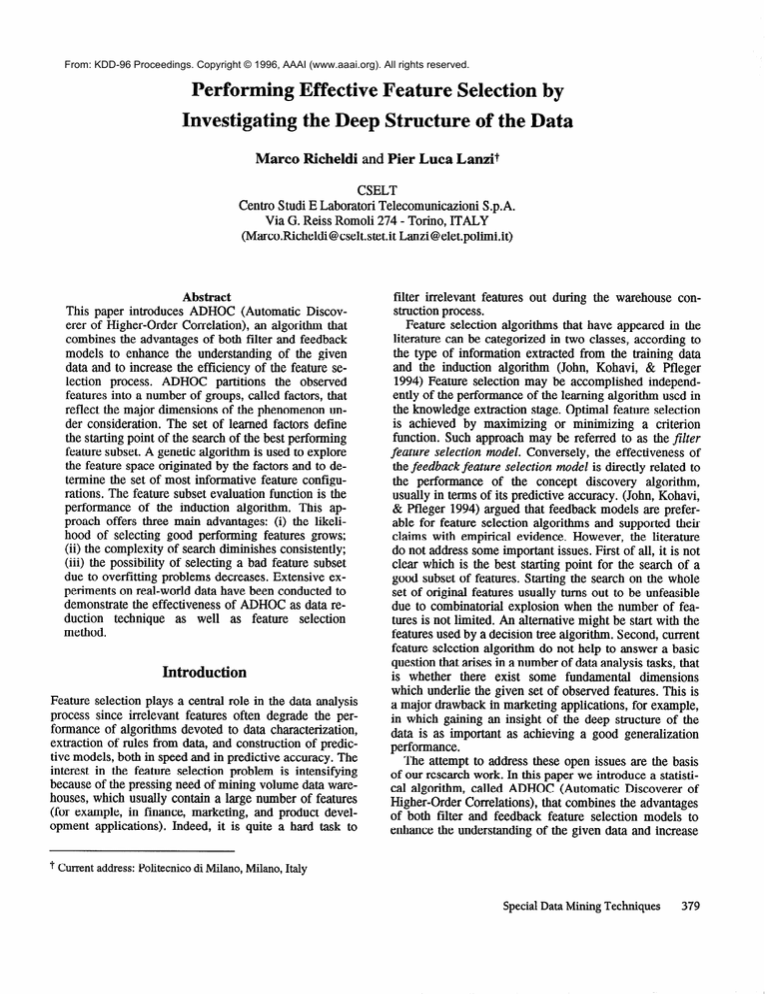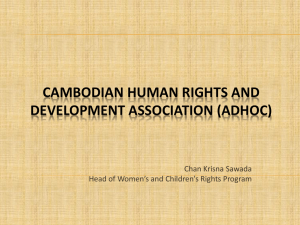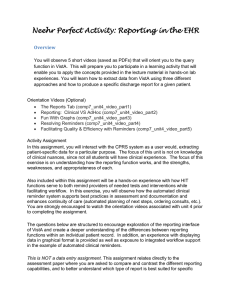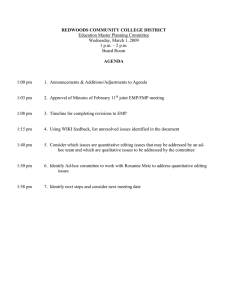
From: KDD-96 Proceedings. Copyright © 1996, AAAI (www.aaai.org). All rights reserved.
Performing Effective Feature Selection by
Investigating the Deep Structure of the Data
Marco Richeldi and Pier Luca Lanzii
CSELT
Centro Studi E LaboratoriTelecomunicazioniS.p.A.
Via G. Reiss Romoli 274 - Torino, ITALY
(Marco.Richeldi@cselt.stet.itLanzi@elet.polimi.it)
Abstract
This paper introducesADHOC (Automatic Discoverer of Higher-OrderCorrelation),an algorithm that
combinesthe advantagesof both filter and feedback
models to enhancethe understandingof the given
data and to increasethe efficiency of the feature selection process. ADHOC partitions the observed
featuresinto a numberof groups,called factors, that
reflect the major dimensionsof the phenomenonunder consideration.The set of learnedfactors define
the startingpoint of the searchof the best performing
featuresubset.A geneticalgorithm is usedto explore
the featurespaceoriginatedby the factors and to determine the set of most informative feature configurations. The featuresubsetevaluationfunction is the
performanceof the induction algorithm. This approach offers three main advantages:(i) the likelihood of selecting good performing features grows;
(ii) the complexity of searchdiminishesconsistently;
(iii) the possibility of selecting a bad feature subset
due to over-fittingproblemsdecreases.Extensive experimentson real-world data have beenconductedto
demonstratethe effectivenessof ADHOC as data reduction technique as well as feature selection
method.
Introduction
Featureselectionplays a central role in the data analysis
process since irrelevant features often degradethe performanceof algorithms devoted to data characterization,
extraction of rules from data, and constructionof predictive models,both in speedand in predictive accuracy.The
interest in the feature selection problem is intensifying
becauseof the pressingneedof mining volume data warehouses,which usually contain a large numberof features
(for example, in finance, marketing, and product development applications). Indeed, it is quite a hard task to
filter irrelevant features out during the warehouseconstructionprocess.
Featureselection algorithms that have appearedin the
literature can be categorizedin two classes,according to
the type of information extracted from the training data
and the induction algorithm (John, Kohavi, & Rfleger
1994) Featureselection may be accomplishedindependently of the performanceof the learningalgorithm used in
the knowledgeextraction stage.Optimal feature selection
is achieved by maximizing or minimizing a criterion
function. Such approachmay be referred to as the filter
feature selection model. Conversely,the effectivenessof
the feedbackfeature selection model is directly relatedto
the performance of the concept discovery algorithm,
usually in terms of its predictive accuracy.(John,Kohavi,
& Pfleger 1994)arguedthat feedbackmodels are preferable for feature selection algorithms and supportedtheir
claims with empirical evidence. However, the literature
do not addresssomeimportant issues.First of all, it is not
clear which is the best starting point for the searchof a
good subsetof features.Starting the searchon the whole
set of original featuresusually turns out to be unfeasible
due to combinatorialexplosion when the number of features is not limited. An alternativemight be start with the
featuresusedby a decisiontree algorithm. Second,current
feature selection algorithm do not help to answera basic
questionthat arisesin a numberof dataanalysistasks, that
is whether there exist some fundamental dimensions
which underliethe given set of observedfeatures.This is
a major drawbackin marketing applications,for example,
in which gaining an insight of the deep structure of the
data is as important as achieving a good generalization
performance.
The attempt to addressthese open issuesare the basis
of our researchwork. In this paperwe introducea statistical algorithm, called ADHOC (Automatic Discoverer of
Higher-OrderCorrelations),that combinesthe advantages
of both filter and feedback feature selection models to
enhancethe understandingof the given data and increase
t Current address:Politecnico di Milano, Milano, Italy
SpecialData Mining Techniques
379
the efficiency of the feature selection process. Two empirical analysis on real-world data have been conductedto
demonstratethe effectiveness of ADHOC as data reduction technique as well as feature selection method. Experimental results are presentedand discussedin the last
section of the paper.
Data reduction in ADHOC
Factor Analysis (FA), Principal Component Analysis
(PCA) and Cluster Analysis (hereafter designatedas Statistical Data Reduction Techniques or SDRTs) are well
establishedproceduresthat are effective in many domains.
But the set of mathematical assumptionson which they
rely diminish their applicability in a number of machine
learning and data mining applications. This is mainly due
to the following factors: SDRTs fit a linear model to the
data; are suitable to handle numeric features only; are
often fooled by spurious or masked correlation; the outcome of SDRTs is rarely easy to interpret.
Current statistical techniquesmay not representan optimal solution to the data reduction issue in the data mining framework. The ADHOC algorithm provides a different approachto data reduction that overcomessome of the
problems which degradethe performance of pure statistical techniques. ADHOC accomplishes data reduction in
four stages: (i) Detection of linear and non-linear direct
associationsamong the original features, (ii) Detection of
indirect associations among features by investigating
higher-order correlations, (iii) Clustering of related features to discover the hierarchy of conceptsunderlying the
data, (iv) Selection of the most informative partition of
the features.
Analysis of direct association between features. Input of
the algorithm is a training set of feature-valuedexamples.
In the first stage, ADHOC measuresdirect pairwise association between features by comparing the outcome of
two non-parametric(distribution-free) statistical analysis,
namely, correlation analysis and chi-square analysis.
Measurement of the (linear or non-linear) dependence
between any pair of features are normalized in the range
[-1, l] and collected in a matrix called the first order dependence matrix. Unlike SDRTs, ADHOC can handle
both numeric and symbolic features.Numeric featuresare
automatically discretized with the algorithm describedin
(Richeldi & Rossotto 1995) if they need to be compared
with symbolic features to estimate possible dependence.
ADHOC selects the most appropriate test from a set of
available statistics for any given pair of featuresautomatically. For example, correlation between a real-valued
feature and an ordinal discrete-valuedfeature is estimated
by applying a Stuart’sTau c test.
Analysis
of indirect
association
between
features.
ADHOC identifies groups of features that are equivalent
measuresof some factor. It can be regarded,therefore, as
a clustering technique. However, the mechanismunderlying the formation of clusters is very different from the one
380
Technology Spotlight
employedby cluster analysis of features.
SDRTs rely on the analysis of direct correlation between featuresto perform data summarization.Their goal
is to obtain factors that help to explain the correlation
matrix of the features. But correlation may not provide a
reliable measureof the associationbetween two features,
as it does not take effects of other features into account.
Spurios correlations may occur, or correlations may be
imposed artificially or masked by other features. In this
case, indirect relationships between features need to be
investigated, since direct associations, which are measured by correlation, do not convey enough information to
discover the deepstructure of the data.
ADHOC searchfor indirect associationis basedon the
concept of feature profile. The profile of a feature F denotes which features F is related to and which ones F is
not related to. For example,let A, B, C, D, E, and F be six
features that characterizea given data set. Also, let 0.2,
0.1, -0.8, 0.3, and 0.9, be estimatesof the direct relationships between F and A, B, C, D, and E, respectively. F’s
profile is defined as the vector ~0.2, 0.1, -0.8, 0.3, 0.9,
1.O>. Featureswhich have similar profiles provide different measurementof the sameconcept (data dimension) for
they are equally related (unrelated) to the rest of the features. If the converse were true, two concepts would be
related in two contrasting ways at the same time, a very
much unlikely situation in nature. Comparing feature
profiles may yield more reliable an estimate of true association than a direct measureof association,such as correlation, provided the cardinality of the feature profile is not
too small (at least 4). Since components of the profile
vector express correlations, comparing feature profiles
may be viewed as correlating correlations. The result of
the comparisonhas been named and-order correlation in
(Doyle 1992), to stressout the double application of correlation. Accordingly, standard Pearson’scorrelation coefficient is named I-st order correlation. A statistical test,
called Rti, was designed to estimate profile similarity.
Higher-order correlations between features are computed
by recursive application of the RW statistics. N&order
correlations result in a matrix called the Nth-order dependencematrix. By examining the Nth-order dependence
matrix, one can determine the strength of relationship
between features, and group those features that appearto
be related. The recursive process halts when the profile
similarity of features in each cluster goes over a predefined threshold or a given number of iterations have been
done. Predictor variables may be partitioned into four
different categories of clusters. They are’called Positive-concept, Negative-Concept, Undefined, and Unrelated-Features, respectively, and reflect the different typology and strength of dependencesthat may exist between a set of features. Features that share very similar
profiles, Le., that appearto contribute to the same dimension of the phenomenon,are groupedinto a cluster of type
Positive-Concept. Featuresrelated by a negative association to other featuresare assignedto a Negative-Concepttype cluster. Featureswhich appearnot to influence or to
be influenced significantly by the rest of the featuresform
the Unrelated-Features cluster. The Undefined cluster
contains all the remaining features which can not be assignedto one of the other three types of clusters.
The analysis can then be repeated on each group of
features in turn. The aim is refining the classification, as
for the Positive-Concept clusters, or identifying relationships that could be masked by other features, as for the
Undefined cluster. Cluster refinement is terminated when
cluster cardinality goesbelow to a predefinedvalue.
As a result, ADHOC returns a hierarchy of clusters
which would resemble the hierarchy of concepts that
characterizethe observedphenomenon.A test of homogeneity of content is then applied to every level of the
hierarchy to determinea good factorization of features.
Selection of the best feature subset
The problem of feature selection involves finding a good
subsetof featuresunder some objective function, such as
generalizationperformance or minimal use of input features. In our opinion, a feature subsetcannot be truly informative and, consequently,good performing on unseen
cases,unless it contains at least one feature which contribute to define every dimension underlying the data.
Moreover, if there exist n important concepts that contribute to the target concept, and a feedback model identifies a feature subset with less than n features which
achievesthe best predictive performance,it is very likely
that the subsetover-fit the data. On the other hand, in the
very unlikely case in which data has no structure, every
feature can be regardedas reflecting a single concept and
the searchwould start from the entire set of features. The
searchfor the best feature subset in ADHOC is basedon
the above considerations.The second step of the algorithm consists of selecting at most one feature from each
of the factor, i.e., dimension of the data, that has been
discoveredin the data reduction step. As a consequence,
feature subsetsthat reflect all the problem dimensionsare
formed, and search efficiency strongly increases.We investigated several searchheuristics to select the smallest
number of features from each factor (group of features
which reflect the same data dimension). Among the others, genetic algorithms (GAS) turned out to be an excellent
fit to this task (Vafai & De Jong 1992). Experimental
studies were conducted by forcing the GA to select at
most one feature from each factor, in order to focus the
search on the best performing, least-sized feature subset
which covers all the data dimensions. The feature subset
evaluation function was the generalizationperformanceof
the induction algorithm C4.5. To fairly estimate the prediction accuracy of the learning algorithm, a k-fold crossvalidation technique was applied. The training data set
was broken into k equally sized partitions. The learning
algorithm was run k times; in each run k-l partitions were
usedas training set and the other one as test set. The generalization accuracywas estimatedby averaging the error
rate on the test set over all the k runs. Results, which are
summarizedand discussedin the next section, confmed
the intuition that GAS are able to find highly predictive, in
many casesnearly-optimal, feature subsets.
Experimental
results
We carried out an extensive empirical analysis in order to
evaluate the effectiveness of ADHOC. We selected 14
real-world datasetsfeaturing different types of problematic features, i.e., interacting, redundant and irrelevant
features in different measures.Some of the datasetswere
drawn from the U. C. Irvine Repository (Murphy & Aha
1994), others from the StatLog Repository (Michie, Spieghalter, Jz Taylor 1994) and the COCOMO data set from
(Bohem 1981). The experiments were carried out as follows. Real-valued features were discretized using the algorithm described in (Richeldi dz Rossotto 1995) when
necessary.The selection of the best number of data dimensions was left to the algorithm. The second step of
ADHOC was performed by running C4.5 as induction
algorithm and using the pruned trees. As a consequence,
C4.5 was also used as term of comparison for the accuracy of the resulting feature subsets.To estimate the generalization performanceof feature subsets, lo-fold crossvalidation was used. ADHOC was first run on the training
data; then the test set was used to evaluate the performance of the best feature subsetlearned by GA. The tables
in this section report the averageover the 10 runs.
Table 1 shows that the performanceof feature subsets
discovered by ADHOC improves C4.5 on 11 out of 14
domains. In particular, five times the improvement is
significant at the 95% confidence level and twice at the
90% confidence level. ADHOC’s performance is worse
than C4.5’~ on the remaining three domains, in one of
which, namely Segment, the degradationwas significant
at the 95% confidence level. Table 1 reports also the cardinal@ of the output feature subsets.Lack of spacemakes
it impossible to list the factors as were discovered by
ADHOC in the data reduction step for each dataset.However, we refer the interested reader to (Richeldi & Rossotto 1996) for a description of the results which were
attained for two of the most interesting domains, namely
Germanand COCOMO.
A secondempirical analysis was conducted to evaluate
the performanceof the data reduction algorithm that was
introduced above, hereafter designatedADHOC-DR. The
test was made by comparison with the performance of
factor analysis (FA) and cluster analysis (CA) of features.
Basically, we run ADHOC on the same domains employed in the previous analysis two more times. The first
step of ADHOC was modified to replace ADHOC-DR
with FA and CA in turn. The secondstep of ADHOC was
left unchanged,so that the discovered set of factors were
used as starting point for the search of feature subsets
carried out by the GA. Of course,since FA and CA cannot
handle symbolic features, we had them to work on the
Special Data Mining Techniques
381
of the 11th Int. Conf. on Machine Learning.
Doyle, J. 1992. MCC-Multiple Correlation Clustering. Int.
Journal of Man-Machine Studies37,751-765.
Vafai, H. and De Jong, K. 1992. Genetic algorithms as a
tool for features selection in machine learning. In Proceedings of the 4th International Conference on Tools
with Artificial Intelligence, 200-203.
Bohem, B. W. 1981. Software Engineering Economics.
Prentice Hall.
Richeldi, M. and Rossotto, M. 1995. Class-Driven Statistical Discretization of Continuous Attributes. In Proceedings. of the 8th European Conf. of Machine Learning.
Springer & Verlag.
Murphy, P. M. and Aha, D. W. 1994. UC1 repository of
machine learning databases.
Michie, D.; Spieghalter,D. J. and Taylor, C. C. eds. 1994.
Machine Learning, Neural and Statistical Classification.
Ellis Horwood Publ.
Richeldi, M. and Rossotto, M. 1996. Combining Statistical Techniquesand SearchHeuristic to Perform Effective
Feature Selection. To appear in Machine Learning and
Statistics: the Zntegace.Taylor, C., and Nakhaeizadeh,R.,
eds. John Wiley & Sons.
same input correlation matrix that was used to feed
ADHOC-DR. This was the best way to make a fair comparison among the three methods. Moreover, we run FA
by using different factor extraction and rotation methods,
then reporting the best performance result in case more
alternative factor setswere discovered.
Table 2 summarizescomparison results. It can be noticed that both FA and CA could not process6 out of the
14 datasetsdue to multicollinearity among the features.
ADHOC-DR outperformed statistical data reduction
techniques in all the remaining domains. The improvement was significant over the 95% confidence level in 3
out of 8 domains.Further analysis showedthat each of the
three datasetsis characterizedby quadratic relationships
among features which cannot be discovered by statistical
methodsbasedon linear models. Theseresults support the
claim that investigating higher-ordercorrelation may well
overcome some of the problem of statistical techniques
devotedto data reduction.
References
John, G. H.; Kohavi, R.; and Pfleger, K. 1994. Irrelevant
Featuresand the SubsetSelection Problem. In Procedings
Dataset
Anneal
Australian
Cocomo
CRX
c4.5
%acc f 0
95.6k1.6
84.2k4.0
73.8k21.2
85.Ok4.0
*
19
14
18
15
ADHOC
%acc*o
95.oIk2.3
86.7+_2.8
77.2k21.8
85.1rtr6.1
p-value
**
8
5
7
7
0.292
0.014
0.420
0.941
Dataset
Size
798
690
63
690
Source
UC1
STATLOG
BOHEM
UC1
Table 1. C4.5 and of ADHOC’s predictive accuracy on all the features and on the best feature subset, respectively. * column: no. of
original features; ** column: size of the best feature subset.St. dev. given after the It sign. P-values computed using a two-tailed T test.
Table 2. Percentagepredictive accuracy of ADHOC, Factor Analysis and Cluster analysis. St. dev. given after the f sign. “No.Att”
columns indicate the size of the best performing feature subsets.P-values were computed using a two-tailed T test.
382
Technology Spotlight




